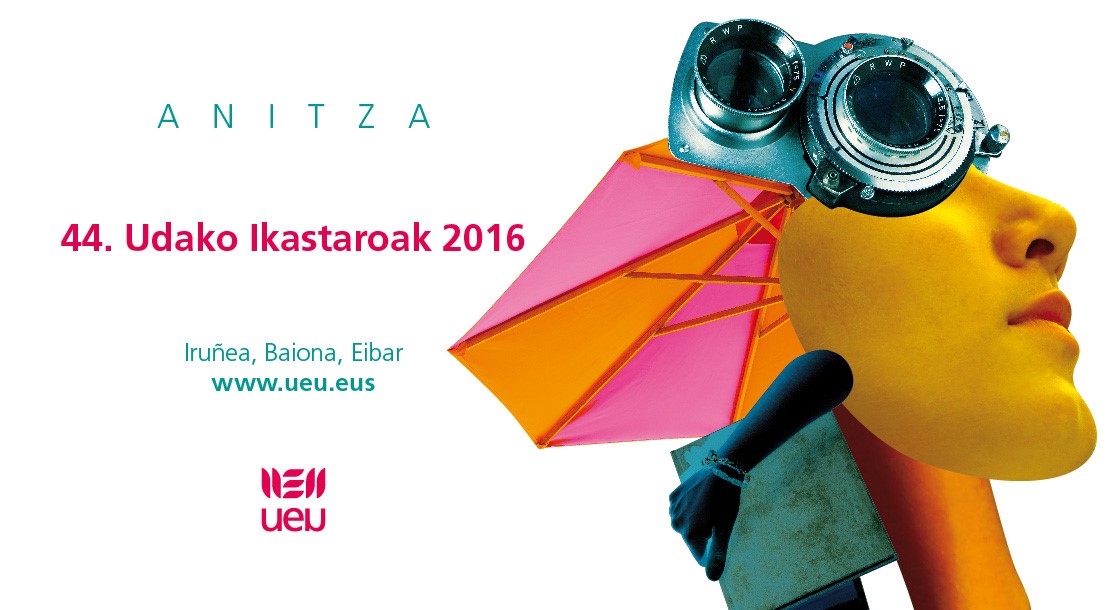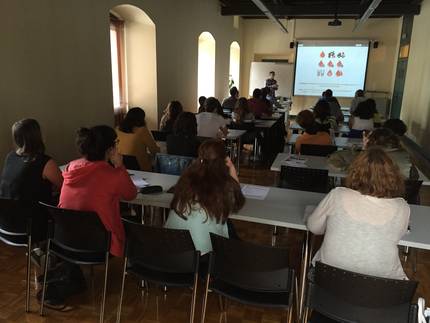Second meeting of Basque mathematicians
2016/08/10 Elisabete Alberdi Celaya - Matematika Aplikatua Saila, UPV/EHU; UEUko Matematika Saila | Naiara Arrizabalaga Uriarte - Matematika Saila, UPV/EHU; UEUko Matematika Saila Iturria: Elhuyar aldizkaria

In 2013 we held the first meeting of Basque mathematicians, and then it became clear that we were many people who did mathematics in Basque. This year's meeting confirmed the existence and prosperity of the quarry of Basque mathematicians. It was a joy to see again some of the faces of the first meeting. The realization that the attempt to bring new people closer paid off also filled us with satisfaction. And it was also clear that this wheel is not paralyzed, but goes at a good pace and engages, creating and sharing ideas.
Although most of us who approached the meeting were mathematicians, there were some who, without being a mathematician, worked on topics of this discipline. This highlights the existence of teams from different disciplines, some of which carry out interdisciplinary work related to mathematics. This meeting was rich in content and formats. The meeting featured a conference of one guest, fourteen communications and a papiroflexia workshop. It should be noted that 3 years ago there were two more communications.
Strategies for process optimization
The guest lecture was given by Carlos Gorria under the title “Some formal and heuristic mathematical strategies for process optimization”. Carlos holds a PhD in mathematics and a professor in the Department of Applied Mathematics and Statistics and Operational Research at the University of the Basque Country. He explained the details of three practical cases he has developed in two companies and in a hospital. In a carpentry company dedicated to cutting boards, he explained the project aimed at obtaining the best rectangles in order to make the most of tree trunks. He explained how mathematics was used in resource management to build a tunnel and told about the strategy used in Galdakao hospital for blood platelet transfusion. In the latter case, with the help of mathematics it was possible to reduce the rate of platelet loss from almost 16% to 12%.
Communications Section
The fourteen communications were divided into 3 sessions, two in the morning and one in the afternoon. From the UPV-EHU, Basque Center for Applied Mathematics (BCAM), Public University of Navarra (UPNA), Cruces and Basurto University Hospitals, École Normale Supérieur (ENS) and the Institut National de Recherche en Informatique et en Automatique (INRIA). As abundant as the origin was what was worked on communications.
The communications section began with some theoretical developments in the field of mathematical analysis. The first topic to be discussed was the evolution of the violence filament equation for the initial schematic data. The initial data were analyzed in a single corner case and in regular polygons. Continuing in the same field of mathematics, another speaker brought us the uncertainty principle and the Schrödinger equation. In it, in addition to remembering Heisenberg's uncertainty principle, we were able to know other known uncertainty principles in mathematics.
We also learned about the applications of mathematics in the health field. The typology of intoxications by children and young people was presented in various regions of the world, as well as the analysis of the multiple correspondences used for the identification of patterns of intoxication and the analysis of clusters. A second study analyzed the incidence of osteoarthritis in the knee and hip joints in the deterioration of quality of life. Research to estimate the benefit of treatment uses utility indices that measure the patient's health status, including the EQ-5D questionnaire. From the specific questionnaire for patients with knee and hip osteoarthritis (WOMAC), we were explained the process of estimating the availability index of EQ-5D. Finally, data were provided on the poor evolution of patients hospitalized for pneumonia in the hospital of Galdakao in 2008 and 2009, explaining how logistic regression has been used to perform this study.
From the health field, we jump to the mathematical model proposed by Manfred Eigen to explain the first steps of life on Earth. We analyzed the model and learned how it was used to explain virus populations.
The meeting also had conferences related to education. One of them presented a series of didactic activities developed with the aim of showing students of 1st and 2nd of Primary the existence of mathematics in real life. The proposal has been based on interdisciplinarity and the time of Physical Education activities have been worked. In another communication we were told by 4th ESO students the experience of incorporating dynamic software into the teaching of algebra. We also learned about a project aimed at identifying common concepts and designing and implementing interdisciplinary learning actions with university students, specifically with engineering students, who work in “Algebran and Geometry” and “Graphic Representation”.
Through didactics, a speaker also spoke about ethnomathematics. The Didactics of Mathematics was born as a didactic discipline in the 1960s, and in the 1990s a series of paradigms emerged that studied mathematics from a social, cultural and political point of view, one of which is what we know as ethnomatic.
We were also able to mathematically analyze two real problems related to mobility. We were able to see how mathematics can be used for bicycle lending in the big capitals of the world. The theory of the middle zone was presented and we were introduced to the use of this theory in public bicycle lending services in capitals such as London, Berlin or Paris. Another speaker addressed the problem of orientation, variant of the well-known problem of the street vendor. In this travel problem, the distances between the villages and the prize for visiting each village are known. The challenge of this problem is to find a route to maximize the prizes obtained along the way, beginning and ending in a previously defined village.
Another topic analyzed was that of the set numbering system based on Stern's succession. In this sense, some interesting examples of the collection of the numbering system of this set were shown.
Adaptive algorithms aimed at creating optimal networks in different engineering problems were also discussed. In the field of time, they explained how an objective oriented adaptation can be made through an extraordinary statement of error, all useful for designing adapted processes.
We can say that the communications space was also adapted to diversity and to the search for the public interest.
Papiroflexia workshop
The papiroflexia workshop, led by José Ignacio Royo, closed the meeting. José Ignacio is a PhD in mathematics and professor in the department of applied mathematics at the University of the Basque Country. In addition to dedicating himself to research, he has worked on the dissemination of this topic, both through the publication of informative articles and through talks or courses. What we call papiroflexia, is known as Japanese worldwide: “origami”. José Ignacio told us that artists who practice papiroflexia use mathematical methods to create various figures.
The workshop focused on three activities. The first objective was to become aware of the A4 proportion when folding the paper. We studied how to bend the diagonal of a rectangle and compared it with the classic construction that is done with rules and compass. He also explained the ratio 1 that has an A4 sheet; we built a regular pentagon with a good approximation and performed an analysis of the error that accumulates when bending with an A4 size envelope. Iterative methods were then observed in the workshop. To do this, practices such as dividing a line into n equal parts, using the Fujimoto technique to obtain the number 1/3, analyzing the error, bending the mouth that gives the kisses using the technique of obtaining 1/3, etc. Finally, the tetrahedron structure was analyzed, which was divided into two parts.
Finding mathematics under the art of papiroflexia can surprise anyone, but mathematicians were especially fascinated and eager to further deepen.
The meeting showed that it is possible to find mathematics from the real cases of life to the intricacies of art. The evaluation of the meeting has been very positive, and we are waiting for the third, hoping that this year will be the same or better.




